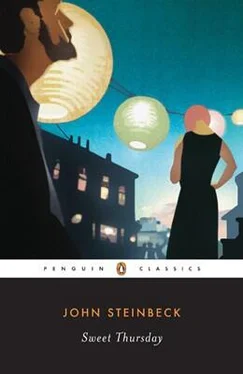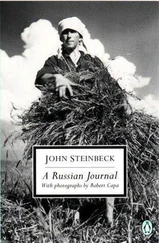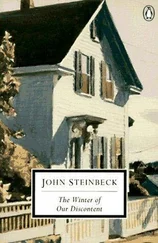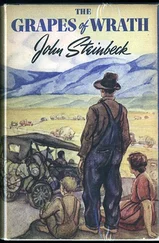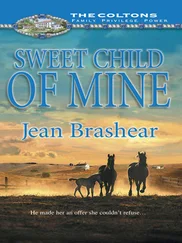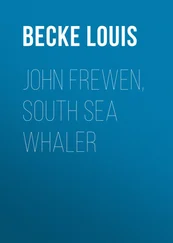John Steinbeck - Sweet Thursday
Здесь есть возможность читать онлайн «John Steinbeck - Sweet Thursday» весь текст электронной книги совершенно бесплатно (целиком полную версию без сокращений). В некоторых случаях можно слушать аудио, скачать через торрент в формате fb2 и присутствует краткое содержание. Год выпуска: 2008, ISBN: 2008, Издательство: Penguin Classics, Жанр: Классическая проза, на английском языке. Описание произведения, (предисловие) а так же отзывы посетителей доступны на портале библиотеки ЛибКат.
- Название:Sweet Thursday
- Автор:
- Издательство:Penguin Classics
- Жанр:
- Год:2008
- ISBN:1-4362-4126-X
- Рейтинг книги:5 / 5. Голосов: 1
-
Избранное:Добавить в избранное
- Отзывы:
-
Ваша оценка:
- 100
- 1
- 2
- 3
- 4
- 5
Sweet Thursday: краткое содержание, описание и аннотация
Предлагаем к чтению аннотацию, описание, краткое содержание или предисловие (зависит от того, что написал сам автор книги «Sweet Thursday»). Если вы не нашли необходимую информацию о книге — напишите в комментариях, мы постараемся отыскать её.
Cannery Row
Sweet Thursday — читать онлайн бесплатно полную книгу (весь текст) целиком
Ниже представлен текст книги, разбитый по страницам. Система сохранения места последней прочитанной страницы, позволяет с удобством читать онлайн бесплатно книгу «Sweet Thursday», без необходимости каждый раз заново искать на чём Вы остановились. Поставьте закладку, и сможете в любой момент перейти на страницу, на которой закончили чтение.
Интервал:
Закладка:
34
Lao-Tse: Major Chinese philosopher said to have lived in the sixth century BCE; however, many historians place his life in the fourth century BCE. He was credited with writing the seminal Taoist work, the Tao Te Ching, and he was recognized as the founder of Taoism.
35
Bhagavadgita: The Bhagavad Gita is a passage of 701 verses in the epic Mahabharata and is revered as a sacred text of Hindu philosophy. Bhagavad Gita, a conversation between divine Krishna and Arjuna, proposes that true enlightenment comes from growing beyond identification with the Ego, the little Self, and that one must identify with the Truth of the immortal Self (the soul, or Atman), the ultimate Divine Consciousness. Through detachment from the personal Ego, the Yogi, or follower of a particular path of Yoga, is able to transcend his mortality and attachment from the material world, and see the Infinite.
36
Prophet Isaiah: Jewish prophet (eighth–seventh centuries BCE) who prophesied during the reigns of four biblical kings and is generally regarded to have authored the Book of Isaiah, which delivers messages of peace, compassion, and justice.
37
Dr. Horace Dormody: In 1930, Dr. Horace Dormody (1897–1984), with his brother Dr. Hugh Dormody, opened Peninsula Community Hospital (renamed Community Hospital of Monterey Peninsula in 1961).
38
Great Tide Pool: An especially rich ecological zone and consequently one of Doc’s prime specimen collecting sites. It is located off Monterey’s Ocean View Boulevard at the western foot of the Point Pinos light house. In chapter 4 of Cannery Row, Steinbeck wrote:
It is a fabulous place: when the tide is in, a wave-churned basin, creamy with foam, whipped by the combers that roll in from the whistling buoy on the reef. But when the tide goes out the little water world becomes quiet and lovely. The sea is very clear and the bottom becomes fantastic with hurrying, fighting, feeding, breeding animals.
39
kraken: Legendary tentacled sea monster of gargantuan size, perhaps inspired by giant squid.
40
Charles Darwin and his Origin of Species: Steinbeck is creating a myth here. According to Brian Railsback in Parallel Expeditions (1995), Darwin never claimed his theory “flashed complete” in such a way. However, the inductive process the novelist suggests, in which a theory emerges after a gathering of facts, does indicate his knowledge of Darwin’s method. Further, Steinbeck is essentially correct in stating that the naturalist spent the rest of his life “backing it up” (Darwin produced six editions of The Origin of Species in his lifetime, the last in 1872, ten years before his death). (p. 26)
41
“Stormy Weather”: Blues song written by musician Harold Arlen (1905–86) and lyricist Ted Koehler (1894–1973) in 1933, about a heartbroken woman who has lost her man. Its first stanza sets the tone for the whole song: “Don’t know why, there’s no sun up in the sky / Stormy weather, since my man and I ain’t together / Keeps raining all the time.” Ethel Waters first sang it at the Cotton Club in Harlem, but it was also memorably performed by Billie Holiday, Ella Fitzgerald, and Lena Horne, who sang it in the movie of the same name in 1943. In 2004 it was chosen by the Library of Congress to be added to the National Recording Registry.
42
Jack Dempsey: William Harrison Dempsey (1895–1983). World heavyweight boxing champion (1919–26) known as the “Manassa Mauler.” Fifty of his sixty wins were by knockout.
43
spick: Insulting, derogatory term for a Hispanic person.
44
The Great Roque War: An American variant of croquet (the name was derived by removing the first and last letters), roque is played on a rolled sand court with permanently anchored wickets. The mallets, with which the ball is struck, have a short handle (approximately twenty-four inches), and the ends of the mallet are faced with stone. According to Susan Shillinglaw’s A Journey into Steinbeck’s California (2006), “There was no such war, with Greens squaring off against Blues,” though in 1932–33 a local tempest erupted in Pacific Grove over attempts to remove the roque courts. Voters resoundingly defeated the move (p. 95).
45
Pacific Grove: Sedate Pacific Grove, Monterey’s next-door neighbor on the Peninsula, began in 1875 as a summer Methodist tent camp and religious retreat (on property owned by land baron David Jack), then in 1879 became the site of a Pacific Coast arm of the Chautauqua Literary and Scientific Circle, modeled on the Methodist Sunday school teachers’ training camp established in 1874 at Lake Chautauqua, New York. Pacific Grove’s roots, as Steinbeck notes, were religiously, philosophically, and politically conservative.
46
Whom the Gods Love…: Parody of a line by Greek tragic dramatist Euripides (480 BCE–406 BCE): “Whom the gods would destroy, they first make mad.”
47
Sorrows of Werther: The Sorrows of Young Werther (1774), loosely autobiographical novel of love and suicide by German writer and scientist Johann Wolfgang von Goethe (1749–1832).
48
A and C: “Ass and collar”—a bouncer’s move, used to grab hold of and then eject a patron. Steinbeck mentions the technique in chapter 23 of Cannery Row as well.
49
Jackson fork: A mechanical hay fork, used for lifting large amounts of hay.
50
William Henry Harrison: Harrison (1773–1841) was an American military leader, a politician, and the ninth president of the United States (1841), who died thirty days into his term—the briefest presidency in U.S. history and the first U.S. president to die while in office.
51
Quod erat demonstrandum: Latin for “that which was to be demonstrated,” indicating that something has been clearly proven. Its acronym, Q.E.D., often appears at the conclusion of mathematical proofs.
52
Harun al-Rashid: Harun (ca. 763–809), fifth Abbasid caliph, who ruled from 786 to 809, was a munificent patron of letters and arts, and under him Baghdad was at its apogee. He became a great figure to the Arabs, who tell about him in many of the stories of the Thousand and One Nights.
53
djinni: In Arabian and Muslim mythology, djinni, or jinni, are intelligent spirits of lower rank than the angels. They are able to appear in human and animal forms and to possess humans.
54
yerba buena tea: Yerba buena (Clinopodium douglasii) is a sprawling aromatic herb of the western and northwestern United States, western Canada, and Alaska, and is used to make tea that is both a medicinal and a refreshing drink. Its name, an alternate form of hierba buena, which means “good herb,” was given by the Spanish priests of California.
55
Holman’s Department Store: According to the Pacific Grove Museum of Natural History (www.pgmuseum.org), this landmark Pacific Grove store was started in 1891, when R. Luther Holman bought Towle’s dry goods store on Light house Avenue near Seventeenth Street. By 1924, when the store moved over two blocks to its new location at 524 Light house Avenue, son Wilford Holman was in charge of operations. Holman’s Department Store, with more than forty different departments, was the largest store on the Pacific coast between Los Angeles and San Francisco, and Highway 68, also known as the Holman Highway, was built in part to bring customers to its doors. The store, having hired a flagpole skater to promote business, appears in chapter nineteen of Cannery Row.
Читать дальшеИнтервал:
Закладка:
Похожие книги на «Sweet Thursday»
Представляем Вашему вниманию похожие книги на «Sweet Thursday» списком для выбора. Мы отобрали схожую по названию и смыслу литературу в надежде предоставить читателям больше вариантов отыскать новые, интересные, ещё непрочитанные произведения.
Обсуждение, отзывы о книге «Sweet Thursday» и просто собственные мнения читателей. Оставьте ваши комментарии, напишите, что Вы думаете о произведении, его смысле или главных героях. Укажите что конкретно понравилось, а что нет, и почему Вы так считаете.
